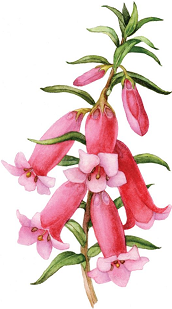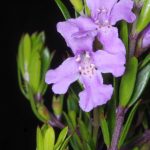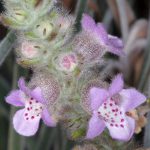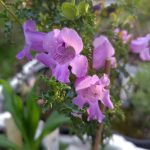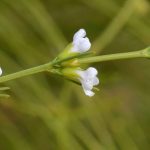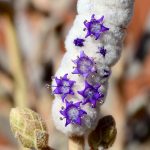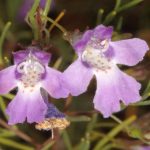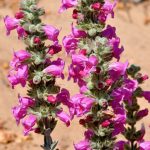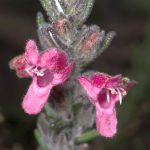
Hosted by Australian Plants Society Yarra Yarra Group.
The online sale is over, but you can click here for plant descriptions, photos & maps (best viewed in Excel)
Mint Bush & Westringia Plant Sales in 2021 – Many species generated for the 2020 Seminar are still available in Super Tubes (90 mm) or 150 mm pots, $5 and $10 each respectively. These are all well grown; the pots in particular can be up to 1m in height. We hope to have plants for sale at the following, if the prevailing COVID guidelines permit – March 13 & 14, APS Vic Quarterly, APS & Districts Warrnambool; April 17, APS Geelong Plant Sale & April 24 APS Yarra Yarra Autumn Plant Sale. Please contact Miriam 0409 600 644 if you want any plants or more specific information.
Program overview:
Lectures: The talks last approximately 30 minutes with 10 for questions. The recorded sessions can be found under the Webinars tab:
- 1st Webinar (Zoom). Thursday 8th October, 7pm-8.30pm: 1. Dr Trevor Wilson – Intimate relationships unveiled; kinships of quirky Australian Mints. 2. Dr. Michael Whitehead – Pollinators, pollination & gene flow in Victorian prostantheras.
- 2nd Webinar (Zoom). Thursday 15th October, 7pm-8pm. Professor Jeremy Bruhl & Dr Ian Telford – Mayhem in the Mints, Systematic study of Prostanthera; resolving misnaming with conseqences for cultivation & conservation.
- 3rd Webinar (Zoom). Thursday 22nd October, 7pm-8.45pm: 1. Maria Hitchcock OAM – Propagation, cultivation, & essential oils of Prostanthera & Westringia genera. 2. Propagation & cultivation of Allied genera; the Kings Park experience. 3. 5min presentation by APS Maroondah on 14th FJC Rogers Seminar in 2022.
For the titles of the presentations & details of garden visits, please refer under the Newsletters tab above on this page.
Garden Visits
Seminar Plant Sales
The online sale is over, but you can click here for plant descriptions, photos & maps (best viewed in Excel)Raffle
| Edition | Contents |
| Oct-Nov 20 | The Oct Webinar Series – Abstracts from our Speakers; Raffle; Fred Rogers, My Primary School Teacher – Elizabeth Doig; The Great Tree Project – Lyhn Barfield; The Cooper Garden; Your 13th FJC Rogers 2020 Seminar Committee |
| Jun-Jul 20 | The new format of the FJC Rogers weekend; Accommodation; Speaker Profiles; Garden Profiles |
| Mar 20 | COVID-19 & halting of registrations; Proposed Program; Plants and Plant Sales; Hanging Baskets; Maria Hitchcock, OAM; Dr Michael Whitehead; Professor Jeremy Bruhl; Dr Ian Telford; Curiosity Spot: Feral Goats and the Brundah Mints; |
| Feb 20 | The FJC Rogers Seminars; Organising Committee; Dates; Venue for Sat 24 Oct 2020; Registrations; Plant Sales; Genera of the Prostantheroideae subfamily; Hanging Baskets; Accommodation |
1. 8th Oct. Intimate relationships revealed! What we have learned from kinships of quirky Australian mints
Dr Trevor Wilson
Biography: Trevor is a postdoctoral fellow at the RBG Sydney, Trevor has been a leading expert on members of the mint family (Lamiaceae) across Australia for the last decade and a half. The Prostantheroideae is a subfamily of the mint family, and it is exclusive to Australia. The group is chiefly recognised by the popularity of Prostanthera and Westringia in horticulture.. With his collaborators, Trevor has been studying these Australian mints, from desert sand dunes to rainforest gullies, and his research demonstrates that distinct shifts have occurred in pollination through Australia’s history.
Abstract: The genus Prostanthera is found only in Australia. A member of the mint family (Lamiaceae), Prostanthera is related to familiar plants such as Mentha and Westringia. Lamiaceae comprise hundreds of species adapted to remarkably different habitats in Australia, from rainforests to desert dunes. Variation in form (e.g. leaf shape or hairiness of the stem) for the members of this family suits the diversity of environmental extremes in Australia, but it also challenges our classification and understanding of relationships. For classifying Australian mints, flower characteristics have been preferentially used since they can be easily compared and provide a neat and tidy organisation of genus and species. But the shape and form of an organism is a product of so much more than what can be immediately observed, and concealed selective forces may also leave their trace on plant structure. In this presentation I discuss the diversity of the mint family in Australia and provide a reinterpretation of relationships with the help of molecular data. As a result, pitfalls in scientific classification and the fascinating trends associated with Australia’s flora are revealed.
2. 8th Oct. Pollinators and pollen flow in Prostanthera
Dr Michael Whitehead and Dr Trevor Wilson
Biography: Michael Whitehead is a plant ecologist and evolutionary biologist. His primary research interests focus on the interaction of plants with animals and fungi. In particular, his work has focused on the way plants and their flowers evolve under the influence of pollinating animals. Michael has conducted research on mimicry and pollination in Australian orchids, flower colour in South African mountain meadows, cryptic orchid-fungal relationships in Western Australia, translocation of endangered flora, and mating patterns across the global diversity of flowering plants. His most recent research fellowship was hosted at University of Melbourne where he investigated the differences in bird and insect pollination in some of our most beloved native shrub genera. He has recently shifted to the government sector as an analyst on invasive species problems.
Abstract: One of the things that attracts people most to Australia’s mint-bushes are the masses of flowers they put on every season. But Prostanthera haven’t evolved flowers for our benefit. Flowers are there for reproduction, which they achieve by persuading animal pollinators to deposit and export pollen. The floral diversity of Prostanthera can be divided into three broad classes of floral forms, each apparently specializing on a particular group of pollinators. For example, there are species which are adapted for pollination by birds, and others suited to native bees. In this presentation, I will describe what we know about Prostanthera’s pollinating animals, as well as how we can use Prostanthera to understand Australian plant-pollinator interactions more generally.
Michael has a great blog with gorgeous photos and wonderful writing about a wide variety of topics. His website is worth visiting and following. Michaelwhitehead.net
3. 15th Oct. Systematic study of Prostanthera is resolving mayhem in the mint bushes, with important consequences for conservation and cultivation
Dr Ian R.H. Telford & Prof. Jeremy J. Bruhl
Biographies:
Professor Jeremy Bruhl
Jeremy is Professor of plant systematics in Botany and Director of the N.C.W. Beadle Herbarium atUNE. Jeremy’s research and research ranges across a large group of plants. His current projects which include Paper-daisies, Phebalium and Prostanthera involve wonderful co-supervision with other people at UNE including Dr Ian Telford. These studies aim to figure out what the species are, estimate their evolutionary relationships, produce new classifications and tools for identification, and understand the conservation status of the species.
Dr Ian Telford
Ian Telford is Honorary Curator of the N.C.W. Beadle Herbarium, School of Environmental and Rural Studies, University of New England, Armidale. After 34 years employed at the Australian National Botanic Gardens, Canberra, as collector/botanist, in his retirement still presses plants and dabbles in taxonomic botany. Within all that Ian still found time as recently as 2014 to undertake a PhD researching the family Phyllanthaceae (tropical rainforest plants). He now concentrates on revisionary studies in Phebalium and Prostanthera, and supervising higher degree students.
Abstract: Plant taxonomy and systematics aim to describe plant diversity (name the species) and resolve evolutionary relationships (phylogeny), which is summarised in classifications. Plant names, classifications and identification tools underpin agriculture, horticulture, natural pharmacology, and diverse research (biochemistry, ecology, plant genetics, plant physiology, etc.). Correct application of names to species is essential. We present case studies of confusion and misapplication of names including overlooked species in Prostanthera lasianthos, P. ovalifolia and P. rotundifolia. Each represents a species complex or even an assemblage of disparate entities that have or will prove to be many distinct species. Description of new species is not a trivial pursuit. Clear, robust, corroborated evidence is needed. We present an example involving the threatened species, P. cineolifera. Similar problems of unresolved assemblages and the misapplication of names occurs widely across plant genera and we draw attention to examples. Vouchers (plant specimens lodged with a recognised herbarium) with sound location data are critical to underpinning sound taxonomic study. We outline what constitutes an ideal collection, and suggest what might be a minimal but useful collection that plant enthusiasts and professional horticulturists should make.
4. 22nd Oct. Propagation and Cultivation of Prostanthera & Westringia
Maria Hitchcock
Biography:
Maria is a retired High School teacher who holds a Bachelor of Arts (UNE) majoring in Botany and a Masters in Professional Studies. She is a Life Member of the Australian Plants Society. She holds the National Correa Collection in her private botanic garden. She published “Correas” in 2010. Maria has been very active in her local community over many years.
She is a founding member of the local APS group and holds membership of many other local organisations and advisory committees. Maria led the campaign for gazetting our National Floral Emblem (Acacia pycnantha) and National Wattle Day. Her book, “A Celebration of Wattle” (2012 Rosenberg) outlines the history of the Wattle Day movement.
She received an Order of Australia medal for services to conservation and the environment in 2018. She currently leads Save our Flora, an independent online projectwhich encourages members to grow and preserve our listed threatened flora. She also runs an online native plants nursery (Cool Natives Nursery) specialising in frost and drought hardy native plants, Waratahs, Flannel Flowers, Correas and Threatened flora.
Abstract: Prostanthera and Westringia form a large group of favoured garden plants. Come October, Prostantheras colour the garden in many shades from white to pink to mauve to deep purple and they usually put on a spectacular show. Westringias follow in summer with their greyish green foliage and white to mauve flowers which are soon covered by butterflies. Both species are relatively easy to propagate by the home gardener. They are grown from cuttings which are best taken in September and October. The process is fairly simple and Maria will take you through in a step by step process to ensure success.
Prostanthera are now sought after by large companies for their antibacterial essential oils which are extracted and sold on to the cosmetics, pharmaceutical, garden chemicals and cleaning products industries. Some Prostantheras have also entered the emerging and fast growing bush food area. There is so much still to learn about the potential of these two genera. Maria hopes to inspire you to grow more of these wonderful plants.
5. 22nd Oct. Propagation and Cultivation of the Allied Genera, the Kings Park Experience
Amanda Shade
Biography:
Amanda began her Botanic Gardens and Parks Authority BGPA career in 1998, working as a nursery horticulturist, before moving into the Nursery Curator role in 2004. The past 22 years at Kings Park have helped her develop a wide range of knowledge and skills associated with the propagation and cultivation requirements of Western Australian flora, as the nursery at Kings Park is responsible for growing plants from all over the state for use in the Western Australian Botanic Garden; for restoration and revegetation projects within BGPA managed natural bushland; for amenity arboricultural plantings; and for various research, education and conservation projects.
She also holds the role of Trainee Coordinator, managing BGPA’s 11 trainees in the workplace and coordinating their studies. She is passionate about the training and development of future generations of horticulturists and conservationists. One of the best things about working in a nursery at a Botanic Garden is the exposure to so many different species that are either newly collected, new to cultivation, threatened in the wild or not commonly seen. I especially enjoy the challenge of learning how best to propagate and cultivate these plants, contributing towards the preservation of our flora, and providing public education about the diversity and importance of the Western Australian flora. Western Australia is home to some incredible specimens within the Prostantheroideae subfamily, and some of them have historically proven to be quite tricky to propagate. Her presentation include highlights of the experiences we have had at Kings Park with trying to address these issues, and how we approach the challenge of cultivating new species outside their natural distribution zones.
Abstract: Amanda begins with a brief overview of Kings Park to provide a bit of context, then explain the nursery’s role in the agency and how we go about propagating a wide range of Western Australian species. She has chosen some case studies on allied mint bush flora to highlight some of our propagation techniques, and will talk about some of our challenges with not just propagation, but bringing some of these unusual and interesting plants into cultivation outside of their natural range. There will also be some strong conservation messages (unfortunately quite a few species in some of these genera are threatened flora)
A note with regard to Amanda Shade & Kings Park regulations -we are not permitted to make the video of her presentation public. Instead Amanda is going to provide us with a PowerPoint presentation with a voice over within a few weeks. We will keep you posted.
